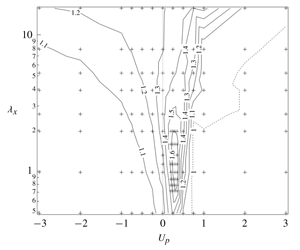Article contents
Dissimilarity between turbulent heat and momentum transfer induced by a streamwise travelling wave of wall blowing and suction
Published online by Cambridge University Press: 16 January 2020
Abstract

A series of direct numerical simulations of a fully developed turbulent channel flow is conducted in order to clarify the effects of travelling wave-like wall blowing and suction on dissimilar heat transfer enhancement. While the wave form is kept sinusoidal and its amplitude is set to be 5 % of the bulk mean velocity, the wavelength and phase speed of the travelling wave are systematically changed in a wide parameter space. As a result, the global optimum of the parameter set for maximizing the analogy factor, which is defined as the ratio between the Stanton number and the skin-friction coefficient, is identified. Interestingly, the obtained globally optimal mode agrees well with that predicted from the optimal control theory taking into account the future dynamics within a limited time horizon by Yamamoto et al. (J. Fluid Mech., vol. 733, 2013, pp. 189–220). The instantaneous velocity and thermal fields are decomposed into coherent and random components in order to evaluate the contribution from each component to dissimilar heat transfer enhancement. The detailed mechanisms of dissimilarity are explained by the budget analyses of the coherent and random contributions. Also, their relationships with the near-wall turbulent structures modified by the applied control are discussed through flow visualization. It is found that the random component makes a dominant contribution to dissimilarity, and this can be explained by an indirect effect through the modification of the coherent field by the applied control. Based on the above mechanisms, we propose a simple unsteady Reynolds-averaged Navier–Stokes (URANS) approach, where the phase-averaged velocity and thermal fields are solved directly whereas the effects of the random component are modelled by the Boussinesq eddy viscosity and diffusivity hypothesis. It is shown that the present URANS can capture the overall trend of dissimilar heat transfer enhancement in a wide parameter range. The present results also explain why the optimal control theory with a limited time horizon succeeds in predicting the globally optimal control mode.
- Type
- JFM Papers
- Information
- Copyright
- © The Author(s), 2020. Published by Cambridge University Press
References
- 19
- Cited by




